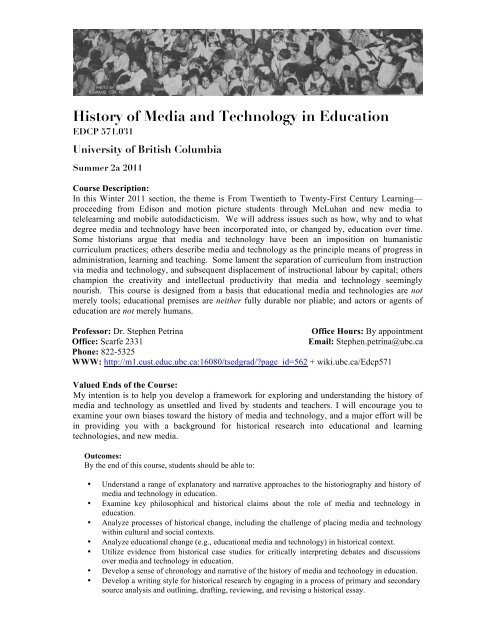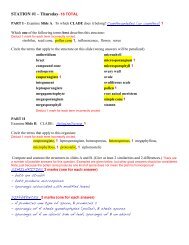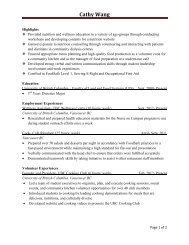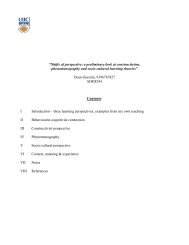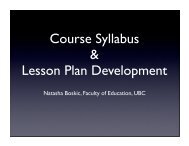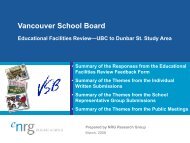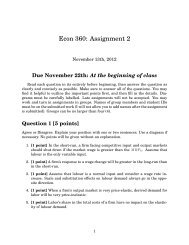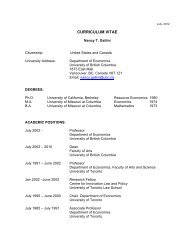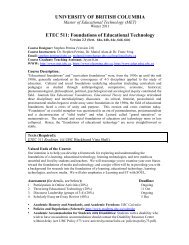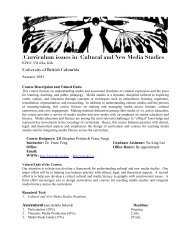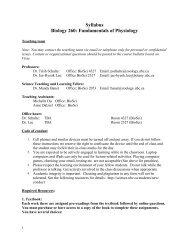History of Media and Technology in Education - UBC Blogs ...
History of Media and Technology in Education - UBC Blogs ...
History of Media and Technology in Education - UBC Blogs ...
Create successful ePaper yourself
Turn your PDF publications into a flip-book with our unique Google optimized e-Paper software.
<strong>History</strong> <strong>of</strong> <strong>Media</strong> <strong>and</strong> <strong>Technology</strong> <strong>in</strong> <strong>Education</strong><br />
EDCP 571.031<br />
University <strong>of</strong> British Columbia<br />
Summer 2a 2011<br />
Course Description:<br />
In this W<strong>in</strong>ter 2011 section, the theme is From Twentieth to Twenty-First Century Learn<strong>in</strong>g—<br />
proceed<strong>in</strong>g from Edison <strong>and</strong> motion picture students through McLuhan <strong>and</strong> new media to<br />
telelearn<strong>in</strong>g <strong>and</strong> mobile autodidacticism. We will address issues such as how, why <strong>and</strong> to what<br />
degree media <strong>and</strong> technology have been <strong>in</strong>corporated <strong>in</strong>to, or changed by, education over time.<br />
Some historians argue that media <strong>and</strong> technology have been an imposition on humanistic<br />
curriculum practices; others describe media <strong>and</strong> technology as the pr<strong>in</strong>ciple means <strong>of</strong> progress <strong>in</strong><br />
adm<strong>in</strong>istration, learn<strong>in</strong>g <strong>and</strong> teach<strong>in</strong>g. Some lament the separation <strong>of</strong> curriculum from <strong>in</strong>struction<br />
via media <strong>and</strong> technology, <strong>and</strong> subsequent displacement <strong>of</strong> <strong>in</strong>structional labour by capital; others<br />
champion the creativity <strong>and</strong> <strong>in</strong>tellectual productivity that media <strong>and</strong> technology seem<strong>in</strong>gly<br />
nourish. This course is designed from a basis that educational media <strong>and</strong> technologies are not<br />
merely tools; educational premises are neither fully durable nor pliable; <strong>and</strong> actors or agents <strong>of</strong><br />
education are not merely humans.<br />
Pr<strong>of</strong>essor: Dr. Stephen Petr<strong>in</strong>a<br />
Office: Scarfe 2331<br />
Phone: 822-5325<br />
Office Hours: By appo<strong>in</strong>tment<br />
Email: Stephen.petr<strong>in</strong>a@ubc.ca<br />
WWW: http://m1.cust.educ.ubc.ca:16080/tsedgrad/page_id=562 + wiki.ubc.ca/Edcp571<br />
Valued Ends <strong>of</strong> the Course:<br />
My <strong>in</strong>tention is to help you develop a framework for explor<strong>in</strong>g <strong>and</strong> underst<strong>and</strong><strong>in</strong>g the history <strong>of</strong><br />
media <strong>and</strong> technology as unsettled <strong>and</strong> lived by students <strong>and</strong> teachers. I will encourage you to<br />
exam<strong>in</strong>e your own biases toward the history <strong>of</strong> media <strong>and</strong> technology, <strong>and</strong> a major effort will be<br />
<strong>in</strong> provid<strong>in</strong>g you with a background for historical research <strong>in</strong>to educational <strong>and</strong> learn<strong>in</strong>g<br />
technologies, <strong>and</strong> new media.<br />
Outcomes:<br />
By the end <strong>of</strong> this course, students should be able to:<br />
• Underst<strong>and</strong> a range <strong>of</strong> explanatory <strong>and</strong> narrative approaches to the historiography <strong>and</strong> history <strong>of</strong><br />
media <strong>and</strong> technology <strong>in</strong> education.<br />
• Exam<strong>in</strong>e key philosophical <strong>and</strong> historical claims about the role <strong>of</strong> media <strong>and</strong> technology <strong>in</strong><br />
education.<br />
• Analyze processes <strong>of</strong> historical change, <strong>in</strong>clud<strong>in</strong>g the challenge <strong>of</strong> plac<strong>in</strong>g media <strong>and</strong> technology<br />
with<strong>in</strong> cultural <strong>and</strong> social contexts.<br />
• Analyze educational change (e.g., educational media <strong>and</strong> technology) <strong>in</strong> historical context.<br />
• Utilize evidence from historical case studies for critically <strong>in</strong>terpret<strong>in</strong>g debates <strong>and</strong> discussions<br />
over media <strong>and</strong> technology <strong>in</strong> education.<br />
• Develop a sense <strong>of</strong> chronology <strong>and</strong> narrative <strong>of</strong> the history <strong>of</strong> media <strong>and</strong> technology <strong>in</strong> education.<br />
• Develop a writ<strong>in</strong>g style for historical research by engag<strong>in</strong>g <strong>in</strong> a process <strong>of</strong> primary <strong>and</strong> secondary<br />
source analysis <strong>and</strong> outl<strong>in</strong><strong>in</strong>g, draft<strong>in</strong>g, review<strong>in</strong>g, <strong>and</strong> revis<strong>in</strong>g a historical essay.
2 <br />
Texts (Required):<br />
EDCP 571 Course Packet. (cost recovery)<br />
1. EDCP 571 Primary & Secondary Sources <strong>in</strong> the <strong>History</strong> <strong>of</strong> <strong>Media</strong> <strong>and</strong><br />
<strong>Technology</strong> <strong>in</strong> <strong>Education</strong>.<br />
Assessment (for details, see below):<br />
Deadl<strong>in</strong>e:<br />
1. Participation <strong>in</strong> Sem<strong>in</strong>ar & Research Activities (20%) Ongo<strong>in</strong>g<br />
2. Historical Discourse Leadership (groups <strong>of</strong> 3) (25%) Ongo<strong>in</strong>g<br />
3. Scholarly Historical Essay (55%) 6 Dec<br />
• Academic Honesty <strong>and</strong> St<strong>and</strong>ards, <strong>and</strong> Academic Freedom: Please refer to <strong>UBC</strong><br />
Calendar<br />
• Policies <strong>and</strong> Regulations (Selected): http://www.students.ubc.ca/calendar<br />
• Academic Accommodation for Students with Disabilities: Students with a disability who<br />
wish to have an academic accommodation should contact the Disability Resource Centre<br />
without delay (see <strong>UBC</strong> Policy #73 www.universitycounsel.ubc.ca/ policies/policy73.pdf).<br />
Participation:<br />
Participation is valued at 20% <strong>of</strong> your f<strong>in</strong>al grade. We refer to the scholarly level <strong>of</strong> participation<br />
as academic conversation, which entails a variety <strong>of</strong> th<strong>in</strong>gs <strong>in</strong>clud<strong>in</strong>g academic conversation,<br />
articulation <strong>and</strong> presentation. Participation is <strong>in</strong>terdependent with preparation for each week,<br />
which <strong>in</strong>volves read<strong>in</strong>g (highlight<strong>in</strong>g, pag<strong>in</strong>ation post-its, marg<strong>in</strong> notes, comments & questions,<br />
etc.), writ<strong>in</strong>g (post<strong>in</strong>g to discussions, note-tak<strong>in</strong>g, outl<strong>in</strong><strong>in</strong>g, question<strong>in</strong>g, def<strong>in</strong><strong>in</strong>g, mapp<strong>in</strong>g,<br />
fram<strong>in</strong>g, summariz<strong>in</strong>g, journal<strong>in</strong>g, blogg<strong>in</strong>g, podcast<strong>in</strong>g, exposition, etc.), organiz<strong>in</strong>g<br />
(document<strong>in</strong>g, labell<strong>in</strong>g, order<strong>in</strong>g, archiv<strong>in</strong>g, fil<strong>in</strong>g, sequenc<strong>in</strong>g events, chronicl<strong>in</strong>g, etc.),<br />
reflect<strong>in</strong>g (reth<strong>in</strong>k<strong>in</strong>g, re<strong>in</strong>corporat<strong>in</strong>g, remapp<strong>in</strong>g, analyz<strong>in</strong>g, synthesiz<strong>in</strong>g, etc.), <strong>and</strong> speak<strong>in</strong>g<br />
(discuss<strong>in</strong>g, podcast<strong>in</strong>g, correspond<strong>in</strong>g with peers, chat, etc.). One goal <strong>of</strong> preparation is to<br />
susta<strong>in</strong> <strong>in</strong>creas<strong>in</strong>gly sophisticated academic conversations or engagement with the read<strong>in</strong>gs,<br />
course <strong>and</strong> peers. A second goal is to develop systematic approaches for engag<strong>in</strong>g with the<br />
read<strong>in</strong>gs <strong>and</strong> your peers (i.e., develop<strong>in</strong>g read<strong>in</strong>g, speak<strong>in</strong>g, writ<strong>in</strong>g, organiz<strong>in</strong>g, <strong>and</strong> reflection<br />
form(at)s <strong>and</strong> styles that are effective). Read for Mean<strong>in</strong>g along with Purpose…<br />
Participation<br />
Low------------Avg------------High<br />
Appropriately <strong>and</strong> accurately articulates key constructs <strong>and</strong> themes <strong>in</strong> read<strong>in</strong>gs, etc.<br />
1---------------3---------------5<br />
Reveals an attempt to synthesize knowledge <strong>of</strong> media <strong>and</strong> technology <strong>in</strong> education<br />
(read<strong>in</strong>gs, etc.).<br />
1---------------5.5--------------10<br />
Advances collective knowledge <strong>and</strong> consciousness by engag<strong>in</strong>g with authors, peers,<br />
<strong>in</strong>structors <strong>in</strong> the onl<strong>in</strong>e course<br />
Total: xx / 20<br />
1---------------3---------------5<br />
1. Scholarly Historical Essay (55%)— Choose a topic that corresponds with one <strong>of</strong> the weekly<br />
topics (or propose a related topic) <strong>and</strong> write a scholarly, publishable paper explor<strong>in</strong>g the history<br />
<strong>of</strong> media <strong>and</strong> technology <strong>in</strong> education. The essay should provide a clear, cogent, concise history<br />
<strong>of</strong> the topic at h<strong>and</strong>. Take a position (state a thesis or argument) <strong>and</strong> provide evidence, through
3 <br />
examples <strong>and</strong> historical narrative, to support the position. Be creative <strong>and</strong> choose a topic that<br />
really <strong>in</strong>terests you! At the mid-po<strong>in</strong>t <strong>of</strong> the course, please also br<strong>in</strong>g a *one page hard copy<br />
outl<strong>in</strong>e* <strong>of</strong> your paper as a work <strong>in</strong> progress. Outl<strong>in</strong>e = outl<strong>in</strong>e form. This <strong>in</strong>cludes the:<br />
1. Historical topic <strong>and</strong> time / chronology<br />
2. Theme <strong>and</strong> argument<br />
a. The argument or thesis<br />
b. The background<br />
3. Primary <strong>and</strong> Secondary sources for <strong>in</strong>sight <strong>in</strong>to the topic<br />
a. Issues to be addressed<br />
b. Literature to be consulted<br />
4. Provisional conclusions drawn from the argument & issues or data<br />
5. Structure / sections <strong>of</strong> the paper<br />
Assessment: (Limit to 10-12, tight well-written double-spaced pages <strong>in</strong>clud<strong>in</strong>g title page<br />
(limit to 3000 words + references).<br />
1. Clarity <strong>of</strong> communication / writ<strong>in</strong>g<br />
a. Is the writ<strong>in</strong>g clear <strong>and</strong> concise<br />
b. Are the ideas focused <strong>and</strong> organized<br />
2. Development <strong>of</strong> argument / thesis<br />
a. Is the argument coherent Thoughtful Analytical Critical<br />
Sophisticated<br />
3. Exploration <strong>of</strong> content <strong>and</strong> theory<br />
a. Is there evidence <strong>of</strong> critically <strong>and</strong> theoretically explor<strong>in</strong>g the issues<br />
b. Are the ideas theorized, synthesized, extended or applied<br />
4. Examples<br />
a. Are examples sufficient Do examples ground the paper<br />
b. Are there narrative examples<br />
5. Grammar & Style<br />
a. Organization, sentence structure, paragraphs, spell<strong>in</strong>g<br />
b. APA or Chicago Style (format, references)<br />
Scholarly Historical Essay<br />
Low------------Avg------------High<br />
Clarity <strong>of</strong> communication / writ<strong>in</strong>g<br />
1---------------5.5--------------10<br />
Development <strong>of</strong> argument / thesis<br />
1---------------5.5--------------10<br />
Exploration <strong>of</strong> content <strong>and</strong> theory<br />
1---------------8--------------15<br />
Provision <strong>of</strong> effective <strong>and</strong> sufficient examples<br />
1----------------5.5---------------10<br />
Total: xx / 55<br />
Grammar & Style<br />
1----------------5.5---------------10<br />
2. Historical Discourse Leadership (25%)— Choose one week <strong>and</strong> topic on the schedule to<br />
coord<strong>in</strong>ate the sem<strong>in</strong>ar. It will be your responsibility to clearly re/present the topic <strong>and</strong><br />
read<strong>in</strong>g(s), <strong>and</strong> to coord<strong>in</strong>ate the discussions. Please use the approach described below. Format:<br />
Group Project— groups <strong>of</strong> 3. For the discussion that you lead, please prepare to:
1. Outl<strong>in</strong>e the read<strong>in</strong>gs (primary <strong>and</strong> secondary sources) <strong>and</strong> post this outl<strong>in</strong>e to the group.<br />
2. Provide a brief overview <strong>of</strong> the read<strong>in</strong>gs based on the outl<strong>in</strong>e.<br />
3. Def<strong>in</strong>e key terms or methodological <strong>and</strong> theoretical concepts that are challeng<strong>in</strong>g.<br />
4. Design h<strong>and</strong>outs, discussion questions <strong>and</strong> presentation media for clarify<strong>in</strong>g the read<strong>in</strong>gs.<br />
5. Design activities for the group with attention to <strong>in</strong>clusive participation. Possible activities<br />
<strong>in</strong>clude:<br />
• Discussion focus questions <strong>and</strong> moderation <strong>of</strong> discussion forums<br />
• Wiki / Interactive Web<br />
• Voice & Podcast, etc.<br />
6. Moderate <strong>and</strong> br<strong>in</strong>g closure to the topic for the week.<br />
4 <br />
Historical Discourse Leadership<br />
Low------------Avg------------High<br />
Outl<strong>in</strong>es & addresses key concept(s) <strong>in</strong> read<strong>in</strong>gs<br />
1---------------5.5----------------10<br />
Sufficient examples from read<strong>in</strong>gs are provided & synthesizes with previous read<strong>in</strong>gs<br />
1---------------5.5----------------10<br />
Total: xx / 25<br />
Communication <strong>and</strong> media are pr<strong>of</strong>essional <strong>in</strong> format—<br />
Style is clean <strong>and</strong> coherent<br />
1---------------3---------------5<br />
Grad<strong>in</strong>g Guidel<strong>in</strong>es<br />
Approved July 2008<br />
A level - Good to Excellent Work<br />
A+ (90-100%) A very high level <strong>of</strong> quality throughout every aspect <strong>of</strong> the work. It shows the <strong>in</strong>dividual (or<br />
group) has gone well beyond what has been provided <strong>and</strong> has extended the usual ways <strong>of</strong> th<strong>in</strong>k<strong>in</strong>g <strong>and</strong>/or<br />
perform<strong>in</strong>g. Outst<strong>and</strong><strong>in</strong>g comprehension <strong>of</strong> subject matter <strong>and</strong> use <strong>of</strong> exist<strong>in</strong>g literature <strong>and</strong> research.<br />
Consistently <strong>in</strong>tegrates critical <strong>and</strong> creative perspectives <strong>in</strong> relation to the subject material. The work shows a<br />
very high degree <strong>of</strong> engagement with the topic.<br />
A<br />
(85-89%) Generally a high quality throughout the work. No problems <strong>of</strong> any significance, <strong>and</strong> evidence <strong>of</strong><br />
attention given to each <strong>and</strong> every detail. Very good comprehension <strong>of</strong> subject <strong>and</strong> use <strong>of</strong> exist<strong>in</strong>g literature<br />
<strong>and</strong> research. For the most part, <strong>in</strong>tegrates critical <strong>and</strong> creative perspectives <strong>in</strong> relation to the subject material.<br />
Shows a high degree <strong>of</strong> engagement with the topic.<br />
A- (80-84%) Generally a good quality throughout the work. A few problems <strong>of</strong> m<strong>in</strong>or significance. Good<br />
comprehension <strong>of</strong> subject matter <strong>and</strong> use <strong>of</strong> exist<strong>in</strong>g literature <strong>and</strong> research. Work demonstrates an ability to<br />
<strong>in</strong>tegrate critical <strong>and</strong> creative perspectives on most occasions. The work demonstrates a reasonable degree <strong>of</strong><br />
engagement with the topic.<br />
B level - Adequate Work<br />
B+ (76-79%) Some aspects <strong>of</strong> good quality to the work. Some problems <strong>of</strong> m<strong>in</strong>or significance. There are<br />
examples <strong>of</strong> <strong>in</strong>tegrat<strong>in</strong>g critical <strong>and</strong> creative perspectives <strong>in</strong> relation to the subject material. A degree <strong>of</strong><br />
engagement with the topic.<br />
B (72-75%) Adequate quality. A number <strong>of</strong> problems <strong>of</strong> some significance. Difficulty evident <strong>in</strong> the<br />
comprehension <strong>of</strong> the subject material <strong>and</strong> use <strong>of</strong> exist<strong>in</strong>g literature <strong>and</strong> research. Only a few examples <strong>of</strong><br />
<strong>in</strong>tegrat<strong>in</strong>g critical <strong>and</strong> creative perspectives <strong>in</strong> relation to the subject material. Some engagement with the<br />
topic.<br />
B- (68-71%) Barely adequate work at the graduate level.<br />
C & D level - Seriously Flawed Work<br />
C<br />
(55-67%) Serious flaws <strong>in</strong> underst<strong>and</strong><strong>in</strong>g <strong>of</strong> the subject material. M<strong>in</strong>imal <strong>in</strong>tegration <strong>of</strong> critical <strong>and</strong> creative<br />
perspectives <strong>in</strong> relation to the subject material. Inadequate engagement with the topic. Inadequate work at<br />
the graduate level.<br />
NOTE: For <strong>UBC</strong>’s Faculty <strong>of</strong> Graduate Studies (FOGS), a f<strong>in</strong>al mark below 68% for Doctoral students <strong>and</strong><br />
below 60% for Masters students is the equivalent <strong>of</strong> a Fail<strong>in</strong>g mark.
5 <br />
EDCP 571 Course Schedule & Read<strong>in</strong>gs<br />
Sem<strong>in</strong>ars for each week <strong>in</strong>clude a balance <strong>of</strong> activities <strong>and</strong> resources.<br />
Date HDLG Assignments Read<strong>in</strong>gs<br />
Week 1<br />
7 Sept<br />
Week 2<br />
14 Sept<br />
Week 3<br />
21 Sept<br />
Week 4<br />
28 Sept<br />
Week 5<br />
5 Oct<br />
Week 6<br />
12 Oct<br />
Week 7<br />
19 Oct<br />
Week 9<br />
2 Nov<br />
Week 10<br />
9 Nov<br />
Week 11<br />
16 Nov<br />
Week 12<br />
23 Nov<br />
Week 13<br />
30 Nov<br />
Course Intro<br />
Course <strong>in</strong>troduction, Mapp<strong>in</strong>g & Def<strong>in</strong>itions<br />
Historiography: Etymology & Semantics<br />
Read<strong>in</strong>gs<br />
Historiography: The School <strong>of</strong> Tomorrow<br />
Gentry (1984); Petr<strong>in</strong>a (2008); Petr<strong>in</strong>a & Rusnak<br />
(2010)<br />
#2 Read<strong>in</strong>gs & Cuban (1986); Petr<strong>in</strong>a (2002); Morgan (1929)<br />
HDLG<br />
Orality & Literacy<br />
#3 Read<strong>in</strong>gs &<br />
HDLG<br />
Wiman (1969); Merzbach (1971); Comenius<br />
(1657/1887)<br />
Twentieth Century Learn<strong>in</strong>g<br />
#4 Read<strong>in</strong>gs &<br />
Alex<strong>and</strong>er (2010); Edison (1912, 1925)<br />
HDLG<br />
Psy-entific Classrooms & Offices<br />
#5 Read<strong>in</strong>gs &<br />
HDLG<br />
More Learn<strong>in</strong>g <strong>in</strong> Less Time<br />
Luke (1988); Petr<strong>in</strong>a & Rusnak (2010); Gray<br />
(1930/1940); Thurston (1937)<br />
#6 Read<strong>in</strong>gs &<br />
Noble (1991); Gagne (1954)<br />
HDLG<br />
(Week 8) 26 Oct – 1 Nov Read<strong>in</strong>g Break<br />
From Screen <strong>Education</strong> to <strong>Media</strong> Studies<br />
Historical Essay<br />
#7 Proposal due Bolas (2008); Davis (2008); Cambre (1981)<br />
Marshall McLuhan & Underst<strong>and</strong><strong>in</strong>g New <strong>Media</strong><br />
#8 Read<strong>in</strong>gs &<br />
McLuhan (1960, 1967); Moody (1999)<br />
HDLG<br />
The New Cyberculture<br />
#9 Read<strong>in</strong>gs & McHoul (1988); Hilton (1969); Sk<strong>in</strong>ner (1965)<br />
HDLG<br />
Automat<strong>in</strong>g Curriculum & Teledidactics<br />
#10 Read<strong>in</strong>gs &<br />
Bush (1945); Buck (1952); Moore (1972)<br />
HDLG<br />
Individualiz<strong>in</strong>g & Personaliz<strong>in</strong>g Curriculum<br />
-<br />
Historical Essay<br />
Ito (2010)<br />
Due 6 Dec.
6 <br />
Course Schedule:<br />
Each session will generally consist <strong>of</strong> discussion based on read<strong>in</strong>gs. Read<strong>in</strong>gs for each session<br />
will <strong>in</strong>clude a balance <strong>of</strong> secondary <strong>and</strong> primary sources. Each session will also be supplemented<br />
with image <strong>and</strong> sound resources.<br />
Topic 1<br />
Introduction: Historiography, Semantics, Rhetoric <strong>and</strong> Etymology<br />
Read<strong>in</strong>gs / <strong>Media</strong>:<br />
1. Gentry, C. C. (1984). <strong>Education</strong>al technology: A question <strong>of</strong> mean<strong>in</strong>g. In E. E. Miller & M.<br />
L. Mosley (Eds.), <strong>Education</strong>al media <strong>and</strong> technology yearbook (pp. 1-9). Littelton, CO:<br />
Libraries Unlimited.<br />
2. Stephen Petr<strong>in</strong>a, What is Historical Research (August 2008). Vancouver: <strong>UBC</strong>.<br />
3. Petr<strong>in</strong>a, S. & Rusnak, P. (2010). <strong>Technology</strong>. In C. Kridel (Ed.), Encyclopedia <strong>of</strong> curriculum<br />
studies (pp. 876-878). Thous<strong>and</strong> Oaks, CA: Sage.<br />
4. Paul, R. (Executive Producer) & Petr<strong>in</strong>a, S. (2002, October 11). The magic box: <strong>Technology</strong><br />
<strong>in</strong> education (Sound Record<strong>in</strong>g). Wash<strong>in</strong>gton, D.C.: National Public Radio, Sound Pr<strong>in</strong>ts.<br />
Doctoral Sem<strong>in</strong>ar<br />
5. Guillory, J. (2010). Genesis <strong>of</strong> the media concept. Critical Inquiry, 36, 321-362.<br />
Topic 2<br />
The School <strong>of</strong> Tomorrow:<br />
Historiography <strong>of</strong> Material <strong>and</strong> Visual Culture or <strong>Media</strong> & <strong>Technology</strong> <strong>in</strong> <strong>Education</strong><br />
Read<strong>in</strong>gs / <strong>Media</strong><br />
1. Larry Cuban, Teachers <strong>and</strong> Mach<strong>in</strong>es: The Classroom Use <strong>of</strong> <strong>Education</strong>al <strong>Technology</strong> s<strong>in</strong>ce<br />
1920 (New York: Teachers College Press, 1986), 1-8, 104-109.<br />
2. Stephen Petr<strong>in</strong>a, "Gett<strong>in</strong>g a Purchase on 'The School <strong>of</strong> Tomorrow’ <strong>and</strong> Its Constituent<br />
Commodities: Histories <strong>and</strong> Historiographies <strong>of</strong> Technologies," <strong>History</strong> <strong>of</strong> <strong>Education</strong><br />
Quarterly 42 (Spr<strong>in</strong>g 2002): 75-111.<br />
3. Joy Elmer Morgan, "The School <strong>of</strong> Tomorrow," Journal <strong>of</strong> the National <strong>Education</strong><br />
Association 18 (January 1929): 1-2.<br />
4. NEA Film.<br />
Doctoral Sem<strong>in</strong>ar<br />
5. Tilly, Charles. “How (<strong>and</strong> What) are Historians Do<strong>in</strong>g.” American Behavioral Scientist 33<br />
(1990): 685-710.<br />
Topic 3<br />
Orality & Literacy: <strong>Media</strong> & <strong>Technology</strong> <strong>in</strong> <strong>Education</strong> prior to the Twentieth Century<br />
Read<strong>in</strong>gs / <strong>Media</strong><br />
1. Wiman, R. V. (1969). An historical view <strong>of</strong> communication <strong>in</strong> the classroom. In R. V. Wiman<br />
& W. C. Mierhenry (Eds.), <strong>Education</strong>al media: Theory <strong>in</strong>to practice (pp. 5-26. Columbus,<br />
OH: Charles E. Merrill.<br />
2. Uta Merzbach, Of Levers <strong>and</strong> Electrons <strong>and</strong> Learn<strong>in</strong>g <strong>and</strong> Enlightenment (Wash<strong>in</strong>gton, DC:<br />
Office <strong>of</strong> Naval Research, 1971), 1-27.<br />
3. John Amos Comenius, The Orbis Pictus (Syracuse, NY: C. W. Bardeen, 1657/1887).<br />
Doctoral Sem<strong>in</strong>ar<br />
4. Seraf<strong>in</strong>a Cuomo, <strong>Technology</strong> <strong>and</strong> Culture <strong>in</strong> Greek <strong>and</strong> Roman Antiquity (Cambridge:<br />
Cambridge University Press, 2007), 7-40.
7 <br />
Topic 4<br />
Twentieth Century Learn<strong>in</strong>g: Thomas A. Edison, Motion Pictures, <strong>and</strong> Visual <strong>Education</strong><br />
Read<strong>in</strong>gs / <strong>Media</strong><br />
1. Ge<strong>of</strong>f Alex<strong>and</strong>er, Academic Films for the Classroom (Jefferson, NC: McFarl<strong>and</strong> & Company,<br />
2010), 13-37.<br />
2. Thomas Alva Edison, “Mov<strong>in</strong>g Pictures <strong>in</strong> the Classroom,” Literary Digest 44 (6 April<br />
1912): 683-684.<br />
3. Thomas Alva Edison, “What Edison would Like to do with the Movies: An Interview by<br />
Hugh Weir,” Collier’s 75 (21 February 1925): 20-21.<br />
4. Mov<strong>in</strong>g Picture <strong>and</strong> Motion Picture archive.<br />
Doctoral Sem<strong>in</strong>ar<br />
5. Benjam<strong>in</strong>, W. (1936/1968). The work <strong>of</strong> art <strong>in</strong> the age <strong>of</strong> mechanical reproduction. In H.<br />
Arendt (Ed.), Illum<strong>in</strong>ations (trans. H. Zohn) (pp. 217-252). New York: Harcourt, Brace &<br />
World.<br />
Topic 5<br />
Psy-entific Classrooms & Offices: The New Psychology, Tests, Textbooks, <strong>and</strong> Audiovisual<br />
<strong>Education</strong><br />
Read<strong>in</strong>gs / <strong>Media</strong><br />
1. Allan Luke, Literacy, Textbooks <strong>and</strong> Ideology: Postwar Literacy Instruction <strong>and</strong> the<br />
Mythology <strong>of</strong> Dick <strong>and</strong> Jane (New York: Falmer Press, 1988).<br />
2. Petr<strong>in</strong>a, S. & Rusnak, P. (2010). Intelligence tests. In C. Kridel (Ed.), Encyclopedia <strong>of</strong><br />
curriculum studies (pp. 487-488). Thous<strong>and</strong> Oaks, CA: Sage.<br />
3. William S. Gray with Zerna Sharp, Fun With Dick <strong>and</strong> Jane (Toronto: Gage, 1930/1940).<br />
4. Ralph Thurston, “Hitler Mobilizes ‘Mother Goose’,” The Nation 144 (20 March 1937): 317-<br />
318.<br />
Doctoral Sem<strong>in</strong>ar<br />
5. Mona Gleason, "The <strong>History</strong> <strong>of</strong> <strong>Education</strong> <strong>and</strong> the <strong>History</strong> <strong>of</strong> Psychology: What can<br />
Interdiscipl<strong>in</strong>ary Research Offer," Historical Studies <strong>in</strong> <strong>Education</strong> 9 (Spr<strong>in</strong>g 1997): 98-106<br />
Topic 6<br />
“More Learn<strong>in</strong>g <strong>in</strong> Less Time:” The Military, Psychology & <strong>Technology</strong><br />
Read<strong>in</strong>gs / <strong>Media</strong><br />
1. Douglas D. Noble, The Classroom Arsenal: Military Research, Information <strong>Technology</strong> <strong>and</strong><br />
Public <strong>Education</strong> (New York: Falmer Press, 1991), 98-120.<br />
2. Robert M. Gagné, “Tra<strong>in</strong><strong>in</strong>g Devices <strong>and</strong> Simulators: Some Research Issues,” American<br />
Psychologist 9 (March 1954): 95-107.<br />
3. Ohio State Archives (Pressey Papers)<br />
Doctoral Sem<strong>in</strong>ar<br />
4. Haraway, D. (1985). A manifesto for cyborgs. Socialist Review, 15(2), 65-107.<br />
Topic 7<br />
From Screen <strong>Education</strong> to <strong>Media</strong> Studies: Broadcast<strong>in</strong>g, Film, Radio <strong>and</strong> Television<br />
Read<strong>in</strong>gs / <strong>Media</strong><br />
1. Terry Bolas, Screen <strong>Education</strong>: From Film Appreciation to <strong>Media</strong> Studies (Bristol, UK:<br />
Intellect, 2009), 37-68.
2. Michael Davis, Street Gang: The Complete <strong>History</strong> <strong>of</strong> Sesame Street (New York: Vik<strong>in</strong>g,<br />
2008).<br />
3. Marjorie Cambre, "Historical Overview <strong>of</strong> Formative Evaluation <strong>of</strong> Instructional <strong>Media</strong><br />
Products," <strong>Education</strong>al Communication <strong>and</strong> <strong>Technology</strong> 29 (Spr<strong>in</strong>g 1981): 3-25.<br />
8 <br />
Doctoral Sem<strong>in</strong>ar<br />
4. Brian Low, "The New Generation": Mental Hygiene <strong>and</strong> the Portrayals <strong>of</strong> Children by the<br />
National Film Board <strong>of</strong> Canada, 1946–1967,” <strong>History</strong> <strong>of</strong> <strong>Education</strong> Quarterly 43 (December<br />
2003): 540-570.<br />
Topic 8<br />
Marshall McLuhan <strong>and</strong> the Project <strong>in</strong> Underst<strong>and</strong><strong>in</strong>g New <strong>Media</strong><br />
Read<strong>in</strong>gs / <strong>Media</strong><br />
1. McLuhan, H. M. (1960). Report on project <strong>in</strong> underst<strong>and</strong><strong>in</strong>g new media. Wash<strong>in</strong>gton DC:<br />
National Association <strong>of</strong> <strong>Education</strong>al Broadcasters.<br />
2. McLuhan, M. (1967). The medium is the message. NEA Journal, 56(7), 24-27.<br />
3. Kate Moody, The Children <strong>of</strong> Telstar: Early Experiments <strong>in</strong> School Television Production<br />
(New York: Center for Underst<strong>and</strong><strong>in</strong>g <strong>Media</strong>, 1999), 1-23.<br />
4. McLuhan film archive.<br />
Doctoral Sem<strong>in</strong>ar<br />
5. Arthur Kroker, <strong>Technology</strong> <strong>and</strong> the Canadian M<strong>in</strong>d: Innis/McLuhan/Grant (Montreal: New<br />
World Perspectives, 1984), 7-19, 52-86.<br />
Topic 9<br />
The New Cyberculture: <strong>Education</strong>al <strong>Technology</strong>, Teach<strong>in</strong>g Mach<strong>in</strong>es & Programmed<br />
Learn<strong>in</strong>g<br />
Read<strong>in</strong>gs / <strong>Media</strong><br />
1. McHoul, A. (1998). Cybernetymology <strong>and</strong> –ethics. Postmodern Culture, 9(1).<br />
2. Alice Mary Hilton, “Cybernetics: Its Impact on the Processes <strong>of</strong> Learn<strong>in</strong>g, Politics, <strong>and</strong><br />
Production,” <strong>in</strong> Progress <strong>of</strong> Cybernetics, Volume 3 ed. J. Rose (London: Gordon <strong>and</strong> Breach<br />
Science Publishers, 1969), 1287-1297.<br />
3. B. F. Sk<strong>in</strong>ner, “The <strong>Technology</strong> <strong>of</strong> Teach<strong>in</strong>g,” Proceed<strong>in</strong>gs <strong>of</strong> the Royal Society <strong>of</strong> London<br />
162 (27 July 1965): 427-443.<br />
4. Alice Mary Hilton Archives.<br />
Doctoral Sem<strong>in</strong>ar<br />
5. Hannah Arendt, “The Crisis <strong>in</strong> <strong>Education</strong>,” Between past <strong>and</strong> future (New York: Vik<strong>in</strong>g,<br />
1961), 173-196.<br />
Topic 10<br />
Automat<strong>in</strong>g Curriculum <strong>and</strong> Teledidactics: The Automation <strong>of</strong> <strong>Education</strong> via<br />
Correspondence, Distance & Onl<strong>in</strong>e Learn<strong>in</strong>g<br />
Read<strong>in</strong>gs / <strong>Media</strong><br />
1. Vannevar Bush, “As We May Th<strong>in</strong>k,” Atlantic Monthly (July 1945): 47-61.<br />
2. Buck, G. J. (1951). Correspondence education <strong>in</strong> Canada. Phi Delta Kappan, 32(5), 220-222.<br />
3. G. A. B. Moore, “The Growth <strong>of</strong> <strong>Education</strong>al <strong>Technology</strong> <strong>in</strong> Canadian Higher <strong>Education</strong>,”<br />
British Journal <strong>of</strong> <strong>Education</strong>al <strong>Technology</strong>, 1 (January I972): 32-47.<br />
4. NEA <strong>and</strong> Pressey films.
Doctoral Sem<strong>in</strong>ar<br />
5. Toutant, T. S. (2003). Equality by mail: Correspondence education <strong>in</strong> British Columbia,<br />
1919 to 1969. (PhD. Diss., University <strong>of</strong> Victoria). (Download DAI)<br />
9 <br />
Topic 11<br />
Individualiz<strong>in</strong>g & Personaliz<strong>in</strong>g Curriculum: Computers <strong>in</strong> <strong>Education</strong><br />
Read<strong>in</strong>gs / <strong>Media</strong><br />
1. Mizuko Ito, Eng<strong>in</strong>eer<strong>in</strong>g Play: A Cultural <strong>History</strong> <strong>of</strong> Children’s S<strong>of</strong>tware (Cambridge, MA:<br />
MIT Press, 2010), 1-10, 29-84.<br />
2. Misc. Computers <strong>in</strong> <strong>Education</strong> films.
Selected Secondary Sources<br />
For an exhaustive bibliography <strong>and</strong> historiography, see<br />
Stephen Petr<strong>in</strong>a, "Gett<strong>in</strong>g a Purchase on 'The School <strong>of</strong> Tomorrow’ <strong>and</strong> Its Constituent<br />
Commodities: Histories <strong>and</strong> Historiographies <strong>of</strong> Technologies," <strong>History</strong> <strong>of</strong> <strong>Education</strong><br />
Quarterly 42 (Spr<strong>in</strong>g 2002): 75-111.<br />
10 <br />
Examples <strong>of</strong> Practitioner Histories<br />
Charnel Anderson, <strong>History</strong> <strong>of</strong> Instructional <strong>Technology</strong> I: <strong>Technology</strong> <strong>in</strong> American <strong>Education</strong>,<br />
1650-1900, (Wash<strong>in</strong>gton, D.C.: United States Office <strong>of</strong> <strong>Education</strong>, 1961).<br />
Angl<strong>in</strong>, G. J. (Ed.). (1995). Instructional technology: Past, present, & future (2nd ed.).<br />
Englewood, CO: Libraries Unlimited.<br />
George H. Buck, "Teach<strong>in</strong>g Mach<strong>in</strong>es <strong>and</strong> Teach<strong>in</strong>g Aids <strong>in</strong> the Ancient World," McGill Journal<br />
<strong>of</strong> <strong>Education</strong> 24 (W<strong>in</strong>ter 1989): 32-54.<br />
Martha Casas, "The <strong>History</strong> Surround<strong>in</strong>g the Use <strong>of</strong> Sk<strong>in</strong>nerian Teach<strong>in</strong>g Mach<strong>in</strong>es <strong>and</strong><br />
Programmed Instruction (1960-1970)" (Ph.D. diss., Harvard University, 1997).<br />
Edgar Dale, "Historical Sett<strong>in</strong>g <strong>of</strong> Programmed Instruction," <strong>in</strong> Programmed Instruction, 66th<br />
Yearbook <strong>of</strong> the National Society for the Study <strong>of</strong> <strong>Education</strong>, part II ed. Philip Lange<br />
(Chicago: University <strong>of</strong> Chicago Press, 1967), 28-54.<br />
Michael Eraut, "Conceptual Frameworks <strong>and</strong> Historical Development," <strong>in</strong> The International<br />
Encyclopedia <strong>of</strong> <strong>Education</strong>al <strong>Technology</strong> ed. Michael Eraut (New York: Pergamon Press,<br />
1989), 11-21.<br />
James D. F<strong>in</strong>n <strong>and</strong> Paul Saettler, <strong>History</strong> <strong>of</strong> Instructional <strong>Technology</strong>, II: The Technical<br />
Development <strong>of</strong> the New <strong>Media</strong>, (Wash<strong>in</strong>gton, DC: U.S. Office <strong>of</strong> <strong>Education</strong>, 1961).<br />
Gagne, R. M. (Ed.). (1987). Instructional technology: Foundations. Hillsdale, NJ: Lawrence<br />
Erlbaum.<br />
Impagliazzo, J. & Lee, J. A. (Eds.). (2004) <strong>History</strong> <strong>of</strong> comput<strong>in</strong>g <strong>in</strong> education. Norwell, MA:<br />
Kluwer.<br />
Januszewski, A. (2001). <strong>Education</strong>al technology: The development <strong>of</strong> a concept. Westport, CT:<br />
Greenwood.<br />
Johnson, D. L. & Maddux, C. D. (Eds.). (2004). <strong>Technology</strong> <strong>in</strong> education: A twenty year<br />
retrospective. New York: Haworth Press.<br />
Henrietta Lard, Evolutionary Changes <strong>in</strong> <strong>Education</strong>al <strong>Technology</strong>, (Ph.D. diss., Syracuse<br />
University, 1979).<br />
Wesley C. Meierhenry, "A Brief <strong>History</strong> <strong>of</strong> <strong>Education</strong>al <strong>Technology</strong>," <strong>in</strong> <strong>Education</strong>al <strong>Media</strong><br />
Yearbook, 1984 ed. James W. Brown (New York: R. R. Bowker, 1984), 3-13.<br />
Robert M. Morgan, "<strong>Education</strong>al <strong>Technology</strong>: Adolescence to Adulthood" <strong>Education</strong>al<br />
Communication <strong>and</strong> <strong>Technology</strong> Journal 26 (Summer 1978): 142-152.<br />
Reiser, R. (1987). Instructional technology: A history. In Robert M. Gagne (Ed.), Instructional<br />
technology: Foundations. (pp.11-48). Hillsdale, NJ: Lawrence Erlbaum.<br />
Reiser, R.A. (2001). A <strong>History</strong> <strong>of</strong> Instructional Design <strong>and</strong> <strong>Technology</strong>: Part I: A <strong>History</strong> <strong>of</strong><br />
Instructional <strong>Media</strong>. <strong>Education</strong>al <strong>Technology</strong> Research <strong>and</strong> Development, 49(1), 53-64.<br />
Reiser, R.A. (2001). A <strong>History</strong> <strong>of</strong> Instructional Design <strong>and</strong> <strong>Technology</strong>: Part II: A <strong>History</strong> <strong>of</strong><br />
Instructional Design. <strong>Education</strong>al <strong>Technology</strong> Research <strong>and</strong> Development, 49(2), 57–67.<br />
Paul Saettler, The <strong>History</strong> <strong>of</strong> Instructional <strong>Technology</strong> (New York: McGraw-Hill, 1968).<br />
Paul Saettler, "The Roots <strong>of</strong> <strong>Education</strong>al <strong>Technology</strong>," Programmed Learn<strong>in</strong>g <strong>and</strong> <strong>Education</strong>al<br />
<strong>Technology</strong> 15 (February 1978): 7-15.<br />
Saettler, P. E. (1990). The evolution <strong>of</strong> American educational technology. Englewood, CA:<br />
Libraries Unlimited.<br />
Examples <strong>of</strong> Critical Histories<br />
William Bianchi, Schools <strong>of</strong> the Air: A <strong>History</strong> <strong>of</strong> Instructional Programs on Radio <strong>in</strong> the United<br />
States (Jefferson, NC: McFarl<strong>and</strong>, 2008).
11 <br />
Terry Bolas, Screen <strong>Education</strong>: From Film Appreciation to <strong>Media</strong> Studies (Bristol: Intellect,<br />
2009).<br />
Larry Cuban, Teachers <strong>and</strong> Mach<strong>in</strong>es: The Classroom Use <strong>of</strong> <strong>Education</strong>al <strong>Technology</strong> s<strong>in</strong>ce 1920<br />
(New York: Teachers College Press, 1986).<br />
Larry Cuban, "Computers Meet Classroom: Classroom W<strong>in</strong>s," Teachers College Record 95<br />
(W<strong>in</strong>ter 1993): 185-209.<br />
Barbara F<strong>in</strong>kelste<strong>in</strong>, “Dollars <strong>and</strong> Dreams: Classrooms as Fictitious Message Systems, 1790-<br />
1930,” <strong>History</strong> <strong>of</strong> <strong>Education</strong> Quarterly 31 (W<strong>in</strong>ter 1991): 463-487.<br />
Oscar H. G<strong>and</strong>y, "Instructional <strong>Technology</strong>: The Resell<strong>in</strong>g <strong>of</strong> the Pentagon" (Ph.D. diss.,<br />
Stanford University, 1976).<br />
Barbara F<strong>in</strong>kelste<strong>in</strong>, "<strong>Education</strong> Historians as Mythmakers," <strong>in</strong> Review <strong>of</strong> Research <strong>in</strong> <strong>Education</strong><br />
18 ed. Gerald Grant (Wash<strong>in</strong>gton, D.C.: American <strong>Education</strong>al Research Association,<br />
1992), 255-297.<br />
Eric K. Gormly, "Critical Perspectives on the Evolution <strong>of</strong> <strong>Technology</strong> <strong>in</strong> American Public<br />
Schools," Journal <strong>of</strong> <strong>Education</strong>al Thought 30 (December 1996): 263-286.<br />
Donna J. Haraway, "Manifesto for Cyborgs: Science, <strong>Technology</strong> <strong>and</strong> Socialist Fem<strong>in</strong>ism <strong>in</strong> the<br />
1980s," Socialist Review 80 (June 1985): 65-108.<br />
James Ma<strong>in</strong>, "<strong>Education</strong>al <strong>Technology</strong> <strong>and</strong> the Curriculum <strong>of</strong> Production <strong>and</strong> Efficiency, 1950-<br />
1990" (Ph.D. diss., University <strong>of</strong> Houston, 1992).<br />
Noble, D. F. (2002). Digital diploma mills: The automation <strong>of</strong> higher education (Chapter 1).<br />
Toronto: Between The L<strong>in</strong>es.<br />
Douglas D. Noble, The Classroom Arsenal: Military Research, Information <strong>Technology</strong> <strong>and</strong><br />
Public <strong>Education</strong> (New York: Falmer Press, 1991)<br />
Douglas D. Noble, "A Bill <strong>of</strong> Goods: The Early Market<strong>in</strong>g <strong>of</strong> Computer Based <strong>Education</strong> <strong>and</strong> its<br />
Implications for the Present Moment," <strong>in</strong> The International H<strong>and</strong>book <strong>of</strong> Teachers <strong>and</strong><br />
Teach<strong>in</strong>g eds. Bruce J. Biddle, Thomas Good, <strong>and</strong> Ivor Goodson (Dordrecht: Kluwer,<br />
1998), 1321-1375.<br />
Todd Oppenheimer, The Flicker<strong>in</strong>g M<strong>in</strong>d: The False Promise <strong>of</strong> <strong>Technology</strong> <strong>in</strong> the Classroom<br />
<strong>and</strong> How Learn<strong>in</strong>g can be Saved (New York: R<strong>and</strong>om House, 2003), 3-61.<br />
Petr<strong>in</strong>a, S. (2004). Sidney Pressey <strong>and</strong> the automation <strong>of</strong> education, 1924-1934. <strong>Technology</strong> <strong>and</strong><br />
Culture, 45(2), 305-330.<br />
<strong>History</strong> <strong>of</strong> <strong>Media</strong> <strong>and</strong> <strong>Technology</strong> <strong>in</strong> BC <strong>Education</strong><br />
Boshier, R. (1999). Leap<strong>in</strong>g Fjords <strong>and</strong> Conquer<strong>in</strong>g Mounta<strong>in</strong>s: A Chronology <strong>of</strong> Technological<br />
Triumph, Zealotry <strong>and</strong> Utopianism In B.C. <strong>Education</strong>. Vancouver, BC: TERN.<br />
Buck, G. J. (1951). Correspondence education <strong>in</strong> Canada. Phi Delta Kappan, 32(5), 220-222.<br />
Moore, M. G. (1983). The <strong>in</strong>dividual adult learner, In M. Tight (Ed.), Adult learn<strong>in</strong>g <strong>and</strong><br />
education (pp. 153-168). London: Croom Helm.<br />
G. A. B. Moore, “The Growth <strong>of</strong> <strong>Education</strong>al <strong>Technology</strong> <strong>in</strong> Canadian Higher <strong>Education</strong>,” British<br />
Journal <strong>of</strong> <strong>Education</strong>al <strong>Technology</strong>, 1 (January I972): 32-47.<br />
Stephen Petr<strong>in</strong>a, Communications, <strong>Media</strong> & <strong>Technology</strong> <strong>in</strong> Curriculum Studies at <strong>UBC</strong>. (August<br />
2008). Vancouver: <strong>UBC</strong>.<br />
Ruggles, R. H., Anderson, J., Blackmore, D., Lafleur, C., Rothe, J. P. & Taerum, T. (1982).<br />
Learn<strong>in</strong>g at a distance <strong>and</strong> the new technology. Vancouver: <strong>Education</strong>al Research Institute<br />
<strong>of</strong> BC.<br />
Toutant, T. S. (2003). Equality by mail: Correspondence education <strong>in</strong> British Columbia, 1919 to<br />
1969. (PhD. Diss., University <strong>of</strong> Victoria).


